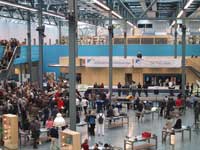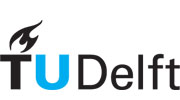Afternoon sessions (invited only)
Designing generates knowledge.
Knowledge that is difficult to acquire by other means, especially in interdisciplinary areas. Knowledge that can be used beyond the product that was designed.
 The growth of knowledge can be represented by a spiral of generating and evaluating, e.g., designing and testing. Many fields of knowledge and ability feed into an interdisciplinary project. In 'research through design', the central arrow can contain a sequence of research prototypes that embody our interaction with the phenomenon that is central to the project. As insight grows, the prototypes get more refined and/or diverse.
The spiral constitutes a vortex: it 'sucks in' knowledge (e.g., theories, insights, mini-solutions) from many sources outside the project, and 'spins off' similar knowledge that can be used in other projects.
The growth of knowledge can be represented by a spiral of generating and evaluating, e.g., designing and testing. Many fields of knowledge and ability feed into an interdisciplinary project. In 'research through design', the central arrow can contain a sequence of research prototypes that embody our interaction with the phenomenon that is central to the project. As insight grows, the prototypes get more refined and/or diverse.
The spiral constitutes a vortex: it 'sucks in' knowledge (e.g., theories, insights, mini-solutions) from many sources outside the project, and 'spins off' similar knowledge that can be used in other projects.
The models of scientific progress have become more complex in the past decades. How do we organize, catch or channel these diverse flows of insight, information, and inspiration?
where we are
Over the last two decades, the value of designing as an important part of research has been established. But the world of research needs new forms to organize and accommodate these types of activities. It often remains difficult to get support for including substantial amounts of designing in a research effort (even more difficult than including research in a commercial design effort).For example, the traditional story of science, as told by academic journals, emphasizes the evaluation of existing ideas in controlled experiments, but leaves the generation of new ideas underexposed. And a lot of knowledge that is 'spun off' from designing gets lost from view.
what we want to achieve
There is a need in the field for 'best practices' about the 'designing as a part of research': how do we get it supported and funded, how do we organize it, how do we preserve the insights we have on the way, and how do we share the results with ourselves and others. In this symposium, we are looking for examples of solutions, more than analysis of problems.
the symposium toolkit

All participants of the afternoon symposium (including the speakers in the morning programme) received a toolkit with 'cognitive mapping' exercises (from the contextmapping repertoire). In these exercises they are asked to create an A3 'miniposter' that graphically expresses their experience with three themes. Each exercise comes with a printed background and a set of pictures and words on stickers to get people started, but no further rules are given. Aim of these exercises is to help all participants sort their own thoughts about designing as a part of research? before the symposium, and to provide visual reference materials during the session.
Participants were also asked to mention up to two projects that 'they want us to know about' when discussing these themes. Below we briefly describe the themes and show the backgrounds and stickers.
theme A: acceptance and support
Designing and doing research are social activities: much depends on the support of others. How are different people related to including designing as a part of doing research. Who needs to be convinced? Which bias must you overcome? How do you get your results published, your project approved? Which people take a lot of convincing, and which are readily in favour?
Make a miniposter of acceptance and support of designing as a part of research. Place those people closer to the center that are already or easily convinced. Place the people who are sceptical or difficult to convince further from the center. Add reasons and considerations where they fit.

theme B: preserving the insight
In designing a lot of insights are generated, but many get lost. Often, the reasons and design decisions behind a product are forgotten. In research, many of the 'little' decisions (and many valuable interdisciplinary ones) don't end up in the end-report.
In this miniposter, depict the tools and techniques you have found to be most helpful in preserving insights. What catches an idea, what keeps an inspiration from getting lost?

theme C: spreading the word
A design project can be seen as a vortex, which sucks in knowledge from a great variety of disciplines, but also generates knowledge that can be spun out. Insights, decisions, examples, instantiations, proofs-of-principle, demonstrators ,? from one project can be used in other projects. In your experience, which formal and informal tools, tricks, techniques work best to promote 'spillover' of design-generated knowledge from one project to another one?
Make a miniposter showing what methods communicate findings best, and to which audiences? Audiences can be colleagues at large, or your direct colleagues in another project, or even your competitors.

contact
email: p.j.stappers@io.tudelft.nlorganization
ID-Studiolabdownloads
symposium posterpaper 100dpi (5.3MB)
paper 150dpi (6.8MB)
onscreen 72dpi (5.3MB)
onscreen 100dpi (6.2MB)
some bios from the web
LaurelCrampton-Smith
Lee
Thackara
our research
speakers in Google
Brenda LaurelGillian Crampton Smith
Kun Pyo Lee
John Thackara






